Although no beach in Cornwall is a complete secret, there is no shortage of inaccessible bays, without car parks, cafes and many of these are perfect for rock pooling. The extra effort of walking (in my case sliding) down a steep field and hauling back up it at the end of the day pays off. This secret beach, one of several between Falmouth and the Helford river is a complete gem, just as diverse as I remember it.
Cornish Rock Pools Junior’s friends who appeared on Countryfile with us have joined us today. Unlike Portreath, the north coast beach we filmed at, it’s incredibly easy to find creatures on this sheltered shore.
Our first discovery is that a population of St Piran’s hermit crabs has established here, probably new since my last visit several years back. I spot the tell-tale red antennae poking out of a shell.
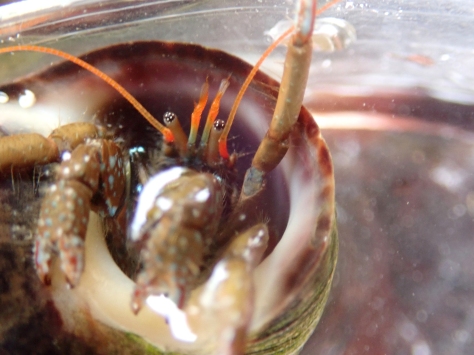
We haven’t gone far before we come across a lovely long pool with plenty of loose boulders to provide protection to sea creatures. As I turn a rock, Junior spots a large fish that shoots out and noses into a clump of seaweed at the edge of the pool to hide. I put Other Half on the case. He skillfully coaxes it into a corner of the pool in the hope it will swim into his big bucket, which it obligingly does.
The underside of the rock I’ve turned is crowded with life. There are colourful patches of sponges and sea squirts. A clutch of yellow eggs coats part of the surface.

These are clingfish eggs and the parent will be nearby. Within them, the babies are developing fast. A pair of eyes gazes out of each egg and the tails, wrapped tightly round the little heads are visible too. Something close by catches my attention, a colourful slug.
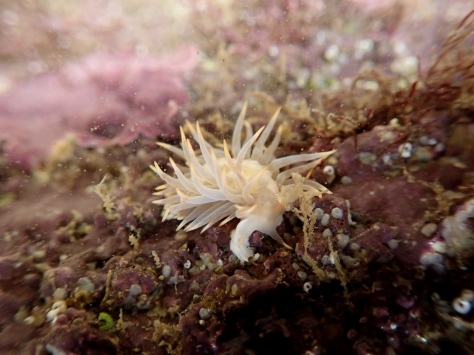
The slug’s long, yellow-tipped cerata sway like hair in the current, giving it a puffed-up appearance. It’s an attractive animal, a pale blue colour when it catches the light. This slug, Calma glaucoides, specialises in eating fish eggs, and especially likes those of the clingfish.
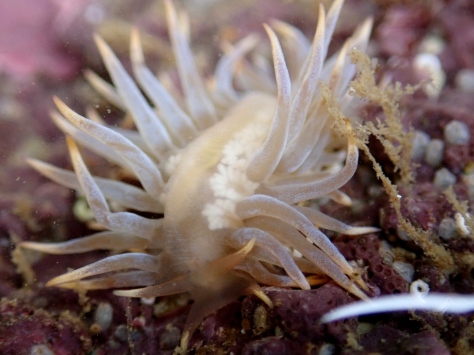
Meanwhile, Other Half and Junior are excited about the fish in their bucket. Junior reckons it’s a giant goby and I think he may be right. I try to pick it up to try to confirm the species by taking a look at the fin under its belly, but the fish is very lively.
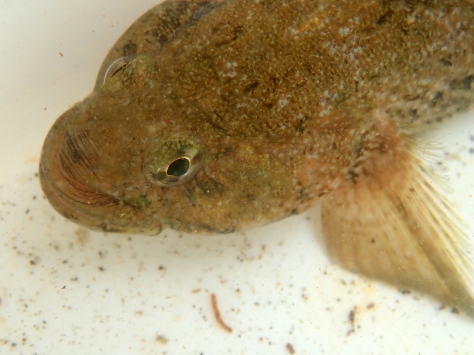
Junior deploys his best trout tickling skills to persuade the fish to lie still in his hands, which it eventually more or less does. The sucker-fin underneath has a thick, pointed lobe at the front.
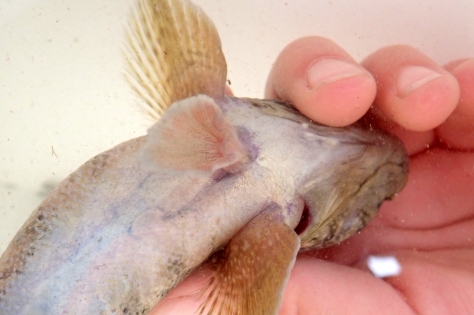
The fish has the small eyes and the salt-and-pepper colouring typical of a giant goby and lacks the yellow band on the top of the first dorsal fin which identified the more common rock goby. Its fins are tipped with grey instead. This fish is highly protected and it’s important not to disturb or trap them without a licence, so, Junior carefully lowers the bucket into the pool allowing his goby friend to swim straight back to its favourite hiding place.
Other finds come in so fast, it’s hard to keep up with them. We come close to catching a huge mystery fish, which thrashes through the seaweed but escapes without being seen. I find a small yellow slug which I initially assume is Jorunna tomentosa, which I often see on the shore. It’s only when I look at the photos at home that I realise my mistake. This slug has lumpy protrusions all over its body that have a sandy, almost warty appearance.
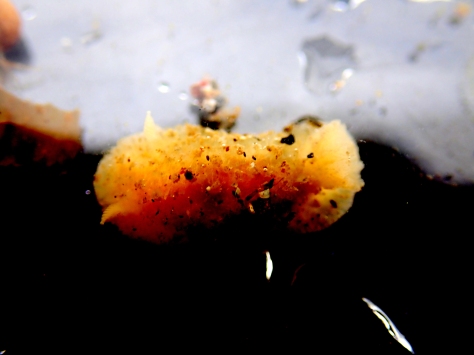
I’ve never seen anything like it, the reason being that this slug has only rarely been recorded in the UK. Doris ocelligera tends to occur further south but seems to be becoming more established in the south of the UK and northern France, with several records coming in over the last few weeks. An exciting find and one I’ll have to look out for more carefully in future.
Thanks go to David Fenwick of Aphotomarine for confirming this slug’s identity.
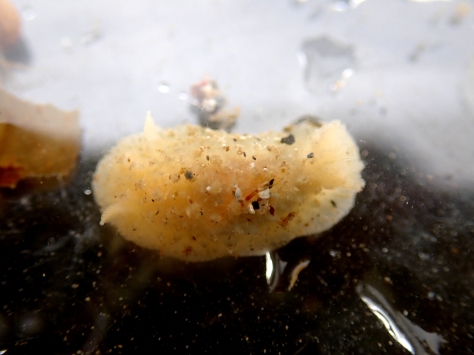
One of Louis’s friends finds this fabulous spider crab.

It’s a female which has decorated herself in so much seaweed that, unless she moves, it’s impossible to tell she’s not just another rock. We have a good look at her amazing stalked eyes and spiny shell before returning her safely into the seaweed.
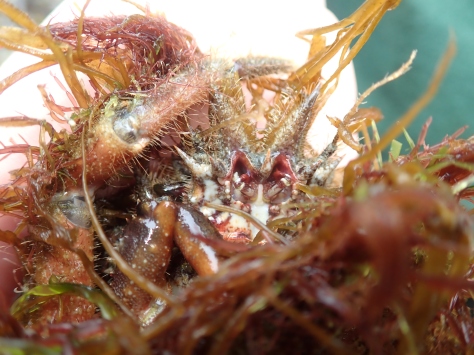
The children’s mums aren’t to be outdone. They get stuck in and bring me all sorts of lovely things. This Ophiothrix fragilis common brittle star has a wonderful bright orange centre.
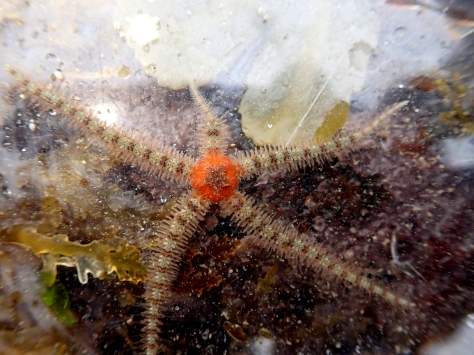
Another mum finds brilliant yellow Berthella plumula slugs, paired together under a stone ready to spawn.

This white-ruffed sea slug (Aeolidella alderi) was another lovely find.

The rocks of the lower shore are covered in all sorts of colourful wildlife. Ciona intestinalis sea squirts tipped with bright yellow rings, blue star ascidian sea squirts and lots of variegated scallops decked out in marbled patterns of brilliant orange and pink.
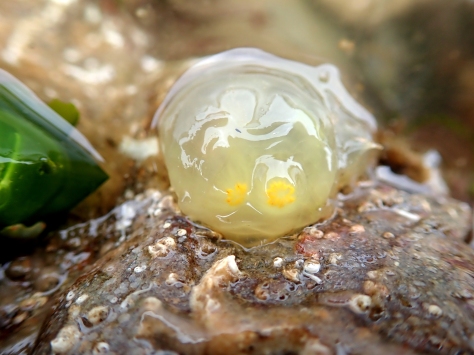
One variegated scallop opens its shell and swims away in jerking side to side movements, like a leaf falling from a tree.

Before we know it, the tide is pushing in and we slip and slide our way across the seaweed-covered rocks back to the sand. The time between the tides is short, just enough to give us a glimpse into this extraordinary marine community before the sea rolls in to cover everything once more. We sit and watch oystercatchers, herons and even a pair of swans fly across the sea, while the children set off into the distance with a metal detector, onto new adventures already.
Visiting a beach like this is an extraordinary privilege. We make sure to leave everything unharmed, to pick up any litter we see and to leave nothing behind. I’m already looking forward to my next visit.
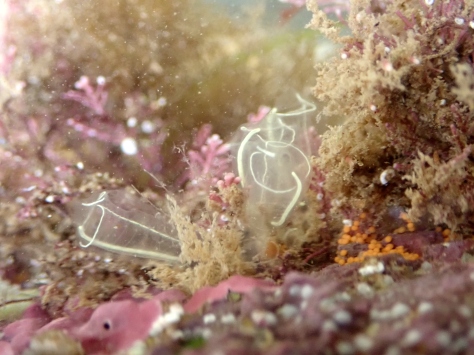


Wonderful spider crab.
LikeLike